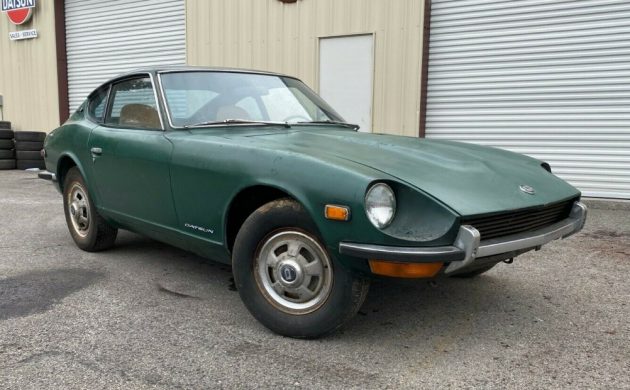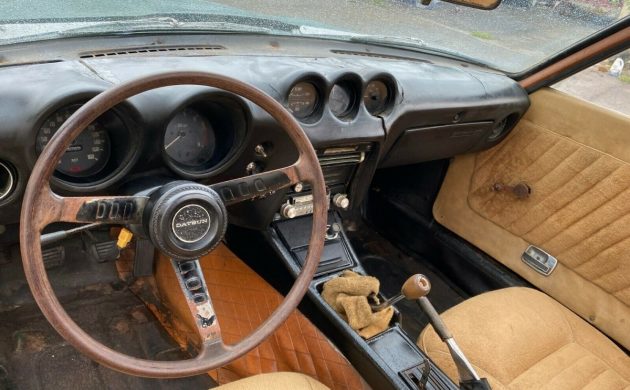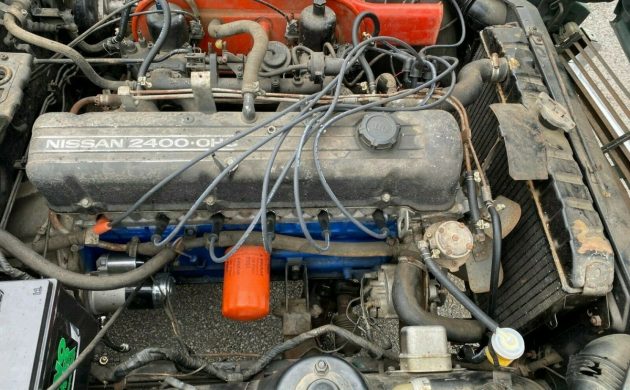When it comes to Datsun Z-cars, the lower the VIN, the better. Series 1 survivors are all the rage right now and have been for a while, so it’s no surprise that this 1970 Datsun 240Z is already bid up to over $10,000 with three days left in the auction. Wearing great colors and seemingly not too rusty, the Z car still runs and drives in addition to having a very low VIN number, indicating early production. The seller notes there are lots of original features still present, and that they have installed several new parts to improve its drivability. The Datsun is listed here on eBay and located in Auburn, Georgia.
These days, when we spot a Series 1 car, it’s usually fairly rough if it hasn’t been restored. The Z car and rust goes together like green eggs and ham, so finding one that isn’t a rot box is essential for it to be a worthwhile restoration project. This car looks correct all the way around, including the badges in the C-pillar and the vents on the rear deck, both Series 1 hallmarks. The slim bumpers that came on the early models are also in good shape and will look fantastic once re-chromed. The hubcaps look like the original ones as well, so this example seemingly checks all the boxes of an early production Z car.
The seller provides a long list of important details that are present on this example that help to document its status as an early model. This includes: the four screw SU carburetors; correct E46 manifold and crossover tube; correct 2400 valve cover; E31 head; numbers matching L24; Series 1 140 lb. oil gauge; Series 1 steering wheel, ashtray, and fiberglass console; correct inspection doors with the plastic-type clips (clips missing); correct Series 1 hood without plate; steel wheels with D hubcaps; and lastly and most rare, are the vented brake shield and scalloped rotors to allow airflow. Finding all of these in one place as opposed to having to hunt them down piecemeal is a huge win for the next owner, but add finding a crack-free dash to the shortlist.
The seller notes they have installed new parts in preparation for sale, including the following: fuel pump, fuel lines, spark plugs, spark wires, coil, electronic ignition, clutch master, rear brake pads, and rear wheel cylinders. There is some rust in the floors that will have to be addressed but other bodywork needs are supposedly fairly minor. The engine bay looks intact and fits with the overall “vibe” of the car being an untouched original. Between the provenance, great colors, and mostly solid bodywork, it’s hard to find fault with a survivor Series 1 like this.






Nice car. Too bad it’s wearing pretty blah colors. Not a lot of sport in this sports car. New paint and interior in brighter colors and you’ve got something worthwhile.
it’s an intact series one car – it WILL go higher than 10K
Nice car, desirable year for the 240Z. Bone simple. Decent performance. Very fun to drive… drove a friend’s when new. I like the color combo; reminds me of the many British sports cars that wear, British Racing Green and have the warm tan tones on the inside. Finished up, she’d be a looker!
Same color combo as my ex-bosses car that he bought brand new. Over 250,000 miles with a valve adjustment every year and she purred like a kitten. One thing people forget on these cars is the steering shaft coupler. They are like a rubber band when new, and like a floppy rag when about 6 years old. I have seen them actually broken and people still driving them. Replace one with a delrin/nylon one and the steering response is amazing. (but you lose the safety factor) Bump up the timing advance a little, install some Bilstein shocks and add some wider wheels and you take a nice car into the “very satisfying/fun bracket in no time! These are fun cans to drive!
I’ve restored 240-300 Z cars.
“Fairly solid” front frame was a good reason to stop driving it.
Severe corrosion and rot through are invisible in the front “frame” areas that also support the front suspension and engine.
We would pass on restorations that failed the ‘poking with an ice pick’ test.
Nothing like downshifting on an off ramp and the engine falls out. Then the front wheels decide that they don’t like being in the correct orientation anymore.
Summer of 1981 wasn’t the best driving year for me.
…as an enthusiastic home mechanic – I just love that view down the side of the motor where you can see the road below and all those engine ancillaries accessible…I’d imagine this is a pretty easy car to work on.
in contrast, I’m in process of planning a couple of major service jobs on my son’s 2009 Mini Cooper S – that engine compartment is “crammed”… I love old cars !
ClassicCarFan. Can appreciate your Mini Cooper adventure. To change out the AC compressor on our ’03 we had to completely strip the front of the car down to the core support, and even then had to pull the lines out to slide the compressor out. The Zs are easy to work on up front but the rear drivetrain is a bit of a challenge. Still, it is nice to see ground through the older cars.
SOLD for $12,200.